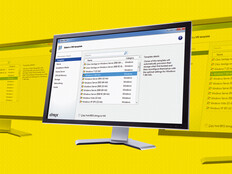HCI and Hybrid Cloud Make a Powerful Healthcare IT Combination
For healthcare organizations everywhere, attitude toward the cloud is changing as new health services and more personalized care call for more robust and flexible underlying infrastructures.
“Market sentiment around the cloud is likely to shift considerably in the next two years with the implementation of new programs such as precision medicine and population health, which would require increased operational and storage flexibility," according to the HIMSS Analytics 2017 Cloud Survey, noting that the cloud can provide the answer to these needs.
While the benefits of the public cloud are well known, healthcare organizations in particular are finding that they need to keep some resources in-house for reasons related to performance, cost or compliance, particularly with personal health information at risk.
For this reason, for many healthcare organizations, a hybrid approach incorporating both on-premises infrastructure and public cloud resources is often the answer. Hyperconverged infrastructure (HCI), which combines computing, storage and networking along with powerful software-based management capabilities into a single solution, is an increasingly popular driver of the hybrid cloud model.
“No matter where you sit today, the ability to scale with great speed and great agility is the business driver,” says Bruce A. Taylor, executive vice president at DatacenterDynamics. “Originally, that was cloud’s province — it was the only way you could hyperscale effectively. That’s no longer true. Hyperconvergence changes the economics of on-premises IT.”
“Many enterprises are having a difficult time finding their way to the public cloud,” Taylor adds. “This gives them a pathway that they simply didn’t have before.”
The Power of Hybrid IT for Healthcare
“When you think about the public cloud, you can swipe a card and get access to as much infrastructure as you want, and you don’t need to hire anyone to manage it,” says Radhika Krishnan, vice president of the Software Defined Infrastructure, Networking and Telco unit of the Lenovo Data Center Group. “You don’t have to worry about systems going down. There is a whole set of perceived benefits around economics, and that’s a big piece of why customers find the public cloud attractive. But after they go through this transition, they sometimes find that it’s not all it’s cracked up to be.”
In some cases, Krishnan says, healthcare organizations have trouble with service-level agreements (SLAs) or overprovision resources in the public cloud. But also, many hospitals and health systems are unwilling to put workloads into the public cloud that are mission-critical, sensitive to latency or subject to regulatory compliance. For these organizations, HCI represents a way to keep certain workloads in-house while still taking advantage of the benefits of the public cloud — and, in fact, mimicking some of those benefits in their own data centers.
“The primary motivation for HCI is simplifying complexity,” Krishnan says. “Now you’re using commodity servers. You’ve dramatically reduced the costs of your hardware infrastructure and you’ve dramatically simplified your environment. All those armies of storage admins that you had earlier, you can repurpose them for more productive areas, as opposed to babysitting storage.”
Krishnan Badrinarayanan, director of product marketing for Nutanix, says that despite the perception that HCI and the public cloud are competitors, the two solutions are in fact “very complementary” to one another. IT leaders are coming to recognize, Badrinarayanan says, that each solution is more appropriate for specific circumstances. “When you have a predictable workload, it makes financial sense to stand up those workloads within the data center,” he says. “But for the ones that are more unpredictable, or when there are spikes in usage, the public cloud is a great fit.”
“It’s about being able to get the best of both worlds,” Badrinarayanan adds. “A hybrid approach gives you the control and predictability of the data center, along with the ability to prepare for the unexpected with the public cloud.”
HCI and VDI Streamline Back-End Healthcare IT
The list of potential use cases for hyperconverged infrastructure is as long as the list of potential IT workloads, but organizations have found particular success with the following:
Virtual desktop infrastructure: VDI deployments can challenge IT staff, but a purpose-built HCI appliance can greatly simplify virtual desktops. Krishnan calls VDI “the killer use case that made HCI very popular” in the first place. Hyperconvergence enables IT teams to deploy more virtual desktops on less hardware, and easily back up, restore or clone virtual machines.
Optimization and development of critical apps: HCI can improve the performance and recovery time of critical applications such as Microsoft Exchange, SQL Server and Oracle. And a hybrid cloud model can give organizations the extra capacity they need to develop and test new apps without making permanent investments in on-premises infrastructure.
“A lot of companies develop apps in public cloud, and then, once the application is ready for prime time, there’s often a move to place those applications back in the data center,” says Badrinarayanan. However, he cautions that healthcare organizations should carefully plan such projects, as moving applications back in-house can be painful if the public cloud and on-premises data center stacks differ significantly.
Data analytics: Gil Shneorson, senior vice president and general manager for Dell EMC VxRail Appliances and VxRack SDDC, says that an HCI hybrid cloud model makes sense for organizations that experience periodic bursts of demand for data analytics, followed by lulls.
“You need to crunch a lot of numbers in a short amount of time,” he says. “Then, once you have the outcome, you don’t really need all that computing power.”
Data protection and disaster recovery: With end-to-end data protection and automated disaster recovery, HCI can help organizations maintain business continuity. The on-demand nature of the public cloud also makes it a popular choice for disaster recovery solutions, meaning that DR is a natural fit for a hybrid cloud approach.
“A lot of companies have a secondary data center purely set up for when disaster strikes,” says Badrinarayanan. “It’s a lot of capital investment that’s not put to the highest use. With the cloud, they can use a Disaster Recovery as a Service provider that will have their back when they need it most.”
Learn more about how CDW solutions and services can help your healthcare organization optimize its data center.








